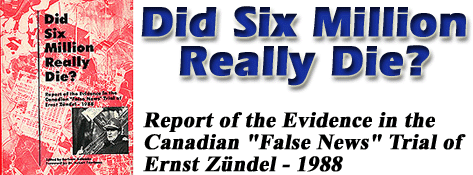
Did Six Million Really Die?
Kenneth Roy Wilson
[Kenneth R. Wilson was the twentieth witness called by the Crown. He testified on Tuesday, April 19, 1988.]
Kenneth R. Wilson was tendered as an expert in photogrammetry, specializing in aerial triangulation, digital mapping and rectification of photographs. He graduated with a Master of Applied Science at the University of Toronto in 1969 in Photogrammetric Engineering, and was a member of the Association of Professional Engineers of Ontario, the Canadian Institute of Surveying and Mapping and the American Society of Photogrammetry and Mapping. (32-8925, 8926) Wilson was asked by the defence to study aerial photographs of Birkenau and Auschwitz taken in 1944 by the Allies. These photographs were enlargements of photographs in the possession of the National Archives in the United States and had been prepared by the Archives staff. (32-8921) His purpose was, firstly, to determine whether black patches appearing on the roofs of the Leichenkellers at Kremas II and III at Birkenau had any elevation; secondly, to determine whether there was any water in the swimming pool at Auschwitz I; and, thirdly, to study the location of a road in relation to the two crematories at Birkenau. (32-8914)
Aerial Photograph No. 3055 (May 31, 1944)
This photograph showed Kremas II and III at Birkenau. Wilson determined that the patches on top of the Leichenkeller at Krema II were flat and had no elevation. (32 8927, 8928) Wilson could not say what the patches were but believed they were discolorations on the surface of the roof. Wilson doubted whether the photograph could be tampered with without it showing up on the 12 times enlargements which he studied. (32-8936)
Aerial Photograph No. 3185 (August 25, 1944)
This photograph showed Kremas II and III at Birkenau and was taken at a scale of 1:10,000. (32-8938) Wilson studied black marks which were visible to the naked eye on the Leichenkellers of both Kremas. He determined that the patches were not shadows but did not have any elevation. He could not identify what the patches were or what caused them. (32-8929, 8930)
Wilson found nothing higher than a metre on the roofs of the Leichenkellers of either Krema II or Krema III. His accuracy, which he considered reasonable, was down to the metre level. The crematorium itself had a roof higher than the ground around it and the chimney was quite high. (32-8931) Wilson could not say what the elevations of the chimneys were. Some of the elevations he obtained were reasonable based on some of the crematories he had seen; some were quite a way out based on stereo geometry. (32-8941-e)
He agreed with Crown counsel that the reference report of the Cartographic Branch of the National Archives rated the image quality of the photograph as "good." (32 8941)
Aerial Photograph No. 6V2 (September 13, 1944)
This photograph also showed Kremas II and III at Birkenau and was taken at a scale of 1:12,000. (32-8939) Wilson could not see stereo with this photograph as it had no stereo mate. He could not detect on the roof of Leichenkeller I of Krema II any of the patches he had seen on the other photographs. He could see only slightly a patch close to the crematorium. On the roof of the Leichenkeller of Krema III, however, he could see a similar pattern of patches as he had seen in the other photographs. On neither roof was there any elevation above one metre. The marks were not shadows. Wilson believed the marks were just patches with no elevation. (32-8931, 8932)
Crown counsel showed Wilson a reference report from the Cartographic Branch of the National Archives which stated with respect to 6V2: "Image quality average. Smoky or hazy appearance because of bombing activity." Wilson agreed haze and smoke would affect image quality if it covered the imagery he was interested in. However, he believed he had good imagery of what he was specifically looking at in this photograph. (32-8940)
Aerial Photograph No. 4058 (November 29, 1944)
This photograph also showed Kremas II and III at Birkenau. Wilson determined that the roof of the dressing room Leichenkeller appeared to have fallen down or to have been removed. (32-8933, 8934)
Auschwitz I Swimming Pool
In several of the photographs of Auschwitz I, Wilson saw what appeared to be a swimming pool. In one photograph, it looked as if diving boards were present. (32 8934) Wilson also believed there was water in the pool based on colour tone and the casting of the shadows along its edge. He agreed a reservoir that had water in it would exhibit the same features. He could not say how old the swimming pool was. (32-8941a, 8941b)
Birkenau Road System
Wilson identified a road leading between Kremas II and III at Birkenau which joined up to other roads to the north of the camp. (32-8934)
Wilson testified that the question of image quality was very much a subjective assessment. Better imagery would be obtained on a photograph taken on a scale of 1:10,000 than on a photograph taken on a scale of 1:23,000. (32-8937, 8938) Because the aerial photographs were taken with a very long focal length, they were not good for determining the height of things based on stereo and the geometry involved in stereo. They were very good, however, for determining elevations of some features based on the shadow that they cast. (32-8941c to 8941e; aerial photographs entered as Exh. 134 at 32-8941g))